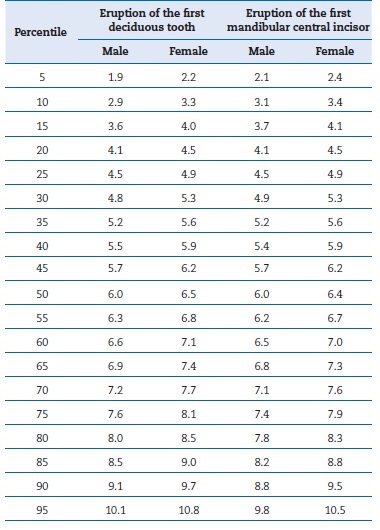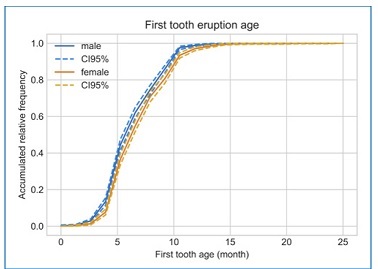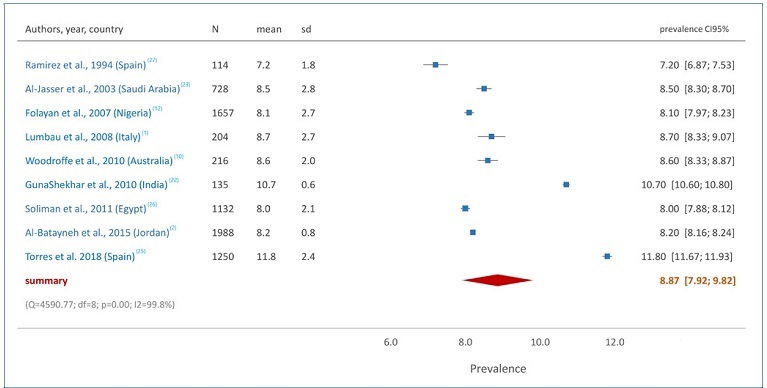Introduction
The dental eruption consists of the movement, mostly axial, of teeth from the alveolar bone to a functional position in the oral cavity.1-5The development of deciduous teeth begins during the prenatal period.1,2,6 Their eruption generally starts with mandibular incisors at about 4-8 months old and ends with the second molars at around 24-36 months old, although a variation of approximately 6 months is acceptable.1-3,5-9The most described sequence for both arches is the following: central incisor, lateral incisor, first molar, canine and second molar.2,5,10,11This sequence may vary, as noted in the study by Woodroffe et al. in 2010, and the most common variation is between maxillary and mandibular central incisors and between maxillary and mandibular lateral incisors.10
The timing of eruption of deciduous dentition has been reported to vary widely between populations, suggesting a strong influence of environmental and genetic factors.1,5,7,8,11-13 Other factors, such as gender, socioeconomic status, gestation time, weight and height at birth, nutritional particularities, and maternal factors, have also been pointed out as having a relevant role.3,4,6-9,11-18 Concerning gender, tooth eruption seems to occur earlier in males than in females.19,20Some studies also reported excessive weight gain and smoking during pregnancy as two of the prenatal factors that could lead to an earlier eruption of deciduous teeth.19,20 Conversely, tooth eruption seems to happen later in premature children with low weight and height at birth.19,20
Knowing the normal pattern of dental eruption allows pediatric clinicians to identify developmental disorders or anomalies and act accordingly.10,14 In addition, the detailed characterization of the age of deciduous teeth eruption for a population is paramount as it can be applied at a forensic level to estimate age, particularly in cases that lack records of birth dates, as well as to identify disaster victims, among others.2,3,12,14
Scientific literature related to this theme is still scarce,9 though some studies, mostly cross-sectional, have been developed to determine the age of eruption in several countries, namely, Jordan, Nigeria, Italy, and Australia.1,2,10,12 Regarding the Portuguese population, there are no systematic records.
Therefore, this study aimed to determine the age of eruption of the first deciduous tooth in a large sample of Portuguese children, establishing percentiles and the corresponding distribution curve for males and females.
Material and Methods
This observational study was conducted in the Center of Portugal in healthy children with a gestational time beyond 37 weeks and normal height and weight at birth. All children with a systemic pathology, preterm delivery, and/or low weight at birth were excluded. The convenience sample consisted of 2115 children aged between 1 and 24 months.
Registration data were collected between January 2000 and December 2018 during the children’s routine pediatric appointments at a private practice to which peers refer children from all over the country. The month the first deciduous tooth erupted was determined by direct observation and report. A single evaluator, who is an experienced clinician, conducted a monthly oral observation under an artificial light source using a tongue depressor to identify the eruption of the first deciduous tooth, recording in months the age in which it occurred.
Any tooth with any part of its crown visible in the oral cavity was considered erupted. The tooth type was also analyzed, although it was impossible to determine which tooth was involved in some cases, mainly between contralateral teeth. Data analysis was conducted at the statistic platform IBM® SPSS® v24, in R v3.3.2 and using Python v3.7.1. The level of significance was set at 0.05. The percentiles of the age of first tooth eruption were determined, along with the cumulative probability curve for males and females. The curves’ confidence bands and the median confidence intervals were calculated using a bootstrapping method with 1000 samples. The proportion and corresponding confidence interval of each tooth type per gender was also determined. Meta-analysis was performed in R using
the metafor package. Random effects models were assumed, and heterogeneity was assessed with the I^2 statistics and Cochran’s Q test. The results were presented in a forest plot (Figure 1).
Results
The sample comprised 2115 children, of which 1090 (51.5%) were male and 1025 (48.5%) female. Table 1 shows the percentiles of the timing of first tooth eruption in months by gender. Percentile 50 was established at 6.0 months for males and 6.5 months for females. Figure 2 shows the cumulative probability curve, with confidence bands, related to the timing of first tooth eruption for both genders. Timings were slightly earlier in the male gender (mean=7.01 (± 2.24); median=6.00 months; 95% CI [5.80, 6.20]) than the female gender (mean=7.55 (± 2.41); median= 6.50 months; 95% CI [6.30, 6.70]). The total sample showed a mean of 7.30 months (± 2.30) and a median of 6.30 months (95% CI [6.10; 6.40]).
Table 1 Percentiles related to eruption timing of the first deciduous tooth and the first mandibular central incisor, in particular, in months.


Figure 2 Cumulative probability curve for the eruption of the first deciduous tooth in males and females.
Table 2 shows the frequency of the first erupted tooth type per gender and the corresponding confidence intervals. There was no statistically significant association (p=0.257) between the tooth type and gender. The mandibular central incisor was more frequently the first deciduous tooth to erupt, occurring in 93.2% (759 of 1090) of males and 94.1% (689 of 1025) of females.
Figure 3 shows the cumulative probability curve, with confidence bands, related to the age of eruption of the first mandibular central incisor per gender. On average, the first mandibular central incisor erupted at 6.94 (±2.10) months in males and 7.49 (±2.17) months in females, not representing a statistically significant difference between genders.
Table 2 Observed frequency (n, %) of the first erupted tooth type per gender and corresponding confidence intervals.

Discussion
The eruption of deciduous teeth is an important milestone in a child’s development. In addition to aesthetic, phonetic, and masticatory functions, it is crucial as an eruption guide for permanent teeth.21
The available scientific literature states that the age of dental eruption varies widely between populations, indicating the influence of genetic and environmental factors. Other factors, such as gender, weight and height at birth, and nutritional patterns, also play a role.21,22 Therefore, gathering specific data on dental eruption timing for each population is important.(22,23
Estimating the age of dental eruption constitutes complementary information for pediatricians and pediatric dentists that allows the identification of developmental anomalies that could lead to systemic repercussions in their patients and contributes to an early implementation of preventive programs against early childhood caries, for example.2,10 Concomitantly, dental age estimation can be largely applied in forensic and anthropological investigations.2,10,12,21
The present study aimed to determine the age at which the first deciduous tooth erupted and establish its relationship with gender. To our knowledge, this is the first study to gather this data specifically regarding the Portuguese population. The results showed that, unequivocally, the mandibular central incisor was most often the first deciduous tooth to erupt, and that happened, on average, at 6.94 (± 2.10) months for males and 7.49 (± 2.17) months for females. Other authors have also identified the mandibular central incisor as the first tooth to erupt, namely Shaweesh et al.24 and Indira et al.21, in Jordanian and Indian children, respectively, although with a slightly later eruption.2,12,21,24 In fact, our study’s sample tended to present an earlier eruption (mean=7.3; median=6.3) than most populations already studied, namely, Spanish, Italian, Australian, Indian, Nigerian, Egyptian, and Saudi Arabian, in which the first deciduous tooth erupted, on average, after the 8 months of age.1,2,10,12,22,23,25-27 The results showed statistically significant differences, as there is no overlap of the confidence intervals.
Several authors have previously studied the relationship between dental eruption and gender, but it still generates controversy.22,23,26The consulted studies indicated some tendency to an earlier eruption in males, and some reported that this tendency only occurred in certain tooth groups.12,25,26,28,29In our sample, the first dental eruption occurred slightly earlier in males (mean=7.01 months; median=6.0 months) than in females (mean=7.55 months; median=6.5 months), with statistically significant differences, although without apparent clinical/physiological relevance. Other studies found similar results, namely Torres et al.25, in which males showed a statistically significantly earlier eruption. On the other hand, Folayan et al.12 in 2007 and Kariya et al.28 in 2017 did not find statistically significant differences between genders.12,23,26,28 The differences between males and females are still poorly justified in the literature. In 2019, Wu et al. 20 hypothesized that this might be associated with differences in sexual maturity and growth pattern.
In both dentitions, dental eruption has been reported as tending to present symmetry between hemi-arches.2,23 Thus, the evaluation of each hemi-arch separately was not considered relevant.
The present study is considered observational (cross-sectional), which implies less risk of bias, larger samples, and better representativeness of the population in question compared to longitudinal studies.28 The results presented as median made statistics more robust and, inherently, more adequate.
Only the results concerning the first mandibular central incisor’s eruption time (considered the first deciduous tooth to erupt) were shown as an average to allow comparison with studies whose results are in this format.21,28
One of this study’s limitations was not considering several factors capable of influencing the age and sequence of dental eruption, as previously mentioned. This evaluation is potentially relevant and promising because it may contribute to the knowledge and particular orientations of pediatricians and pediatric dentists regarding what could be considered physiological and/or potentially pathological and/or require complemental evaluation. Further studies in the Portuguese population with larger samples, possibly nationwide, would be of utmost interest to increase the transversality of results.
Conclusions
To our knowledge, this study was the first to evaluate the age of the first deciduous tooth eruption in a large sample of Portuguese children. Despite its limitations, it concluded that the mandibular central incisor was most often the first deciduous tooth to erupt, which occurred slightly earlier in males, with statistically significant differences between genders, but without relevant clinical and/or physiological translation.
These results may contribute to clinical orientations and highlight the importance and need for a good understanding of this subject, particularly to detect and further explore possible dental developmental disorders ahead of time.

















